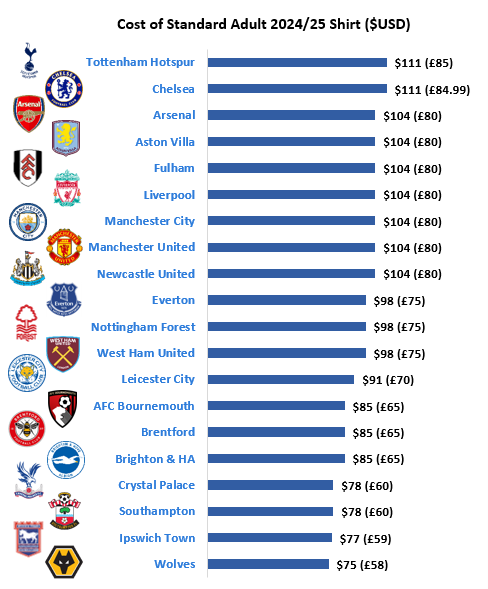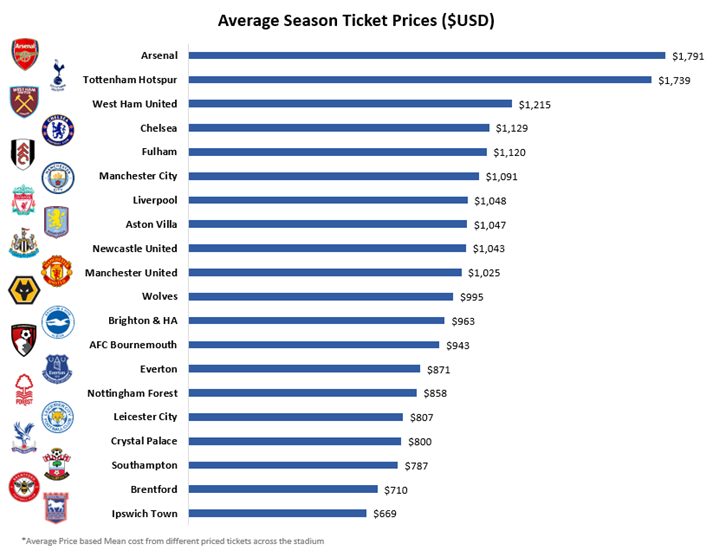
Soccer and the Premier League represent big business, with more money in the game than ever before. At its core, the Premier League is a highly commercial product and all involved are exploiting that.
The league has become widely regarded as the best in the world and this is largely thanks to the riches it can offer. The player transfer market is enough evidence of this, with players handed hundreds of thousands in weekly contracts.
Billions are being thrown around before discussions even reach player contracts, with the league reportedly spending $2.08 billion in this summer’s transfer window alone. Clubs are having to spend more than ever just to compete in the league and the reality is that these costs are also being shifted onto the fans.
Two areas where fans are directly feeling the financial implications are replica shirts and ticket sales. In its formative years (1992), Premier League club shirts were priced at around £30 ($39). Prices across the 20 teams for the 2024-25 season range between £58 ($75) and £85 ($111), with the most common price at £80 ($104).
Tottenham Hotspur have priced themselves at the very top of the market, with Chelsea the only other team to price above £80 ($104). There is a £27 discrepancy between their prices and the lowest in the league, Wolverhampton Wanderers.
The rate of inflation is something that needs to be considered, with the £30 value in 1992 estimated to be worth £64.13 ($83.72) in 2024. Only four clubs currently price their shirts below this value – Crystal Palace, Ipswich Town, Southampton, and Wolves.

US Tariffs are shifting - will you react or anticipate?
Don’t let policy changes catch you off guard. Stay proactive with real-time data and expert analysis.
By GlobalData
The number of shirts sold across the league differs greatly. Liverpool and Manchester United, with the two biggest global fanbases, regularly sell the highest number of shirts, which at the end of the 2022-23 season stood at 1.81 million and 1.8 million shirts each, respectively.
Brighton & Hove Albion are linked to the lowest shirt sales over this time, selling just 43,000 throughout the 2022-23 season.
Based on the cost of a shirt and recorded shirt sales (from 2022-23) there is a huge difference in the amount of revenue this generates across the 20 clubs. Liverpool and Manchester United are linked to overall revenue figures in excess of $187 million.
Conversely, Brighton are linked to a league-lowest revenue stream of $3.83 million a season. Shirt sales across the league account for combined revenue of just under $1.09 billion.
This represents strong income for the 20 Premier League teams but is still significantly lower than that already being generated by sponsorship and media rights. Sponsorship inventory across the league for the 2024-25 season stands at $1.682 billion, and domestic media rights alone is worth $2.27 billion this season.
The figure of $1.09 billion estimated here, however, is not entirely linked to the clubs themselves. Rough guides on how this revenue is split can be as follows:
– 10% attributed to production cost
– 30% to the manufacturer
– 30% to the retailer
– 20% in Value Added Tax (VAT)
– 2.5% on other things such as marketing spend
– And just 7.5% to the club.
This figure of 7.5% given to the club, would drop this $1.09 billion revenue seen by teams to just $81.75 million. This would then average at $4.08 million per club.
7.5% is a standard percentage figure, but there are exceptions to this. Liverpool are a famous example of such, having negotiated terms within their kit supplier contract with Nike, whereby they accepted less money from the brand for a higher taking of its shirt sales (reported at 20%).
For Liverpool, this is estimated to represent an extra $23.53 million each season than at the typical 7.5% figure.
For a family of club supporters who avidly buy home and away shirts, this puts the spend at between $532 and $784 this season, and an average of $659. This is based on a family of four, two adults and two children.
Children’s shirts are worked out at a slightly lower rate (without VAT on their sales). Even with this tax exemption, children’s shirts in the Premier League range between a low of £43 ($56) at Ipswich and £65 ($85) at Tottenham this season.
Alongside shirt price rates, matchday ticket sales are another area where fans are being exploited. The price of an average season ticket in the league this season is estimated to cost between £521 ($669) and £1,394 ($1,791).
The most expensive ticket is linked to Tottenham, whose fans this season are set to pay over two-and-a-half times more than Ipswich, who offer the cheapest average season tickets. The high prices of season tickets are particularly more felt amongst fans of London clubs, with the top five most expensive (average) tickets linked to clubs from the capital.

For context, a Liverpool season ticket for the first Premier League season (1992-93) could be purchased for as little as £250 (at £0.52488 to $1, the 1992 rate). With inflation, that ticket would cost £534.45 in 2024. The average price of a ticket for Liverpool for the 2024-25 season costs $1,048.
This figure doesn’t even come close to the prices seen in North London, where Tottenham and Arsenal sell at an average price in excess of $1,700. The popularity of the sport and the commercial focus of the league in 2024 has seen ticket prices reach ludicrous prices.
Across the 20 teams, Premier League clubs stand to generate an estimated $893,418,706 over the course of the season. This works out at an average of $44.67 million per club. This figure was surpassed in a single transfer during the Premier League summer window this year on at least 20 occasions.
Premier League fans can also feel aggrieved by the lower prices seen across other elite European leagues. The German Bundesliga is famed for cheap season and matchday ticket prices. In the 2023-24 season, the cheapest seated season ticket was €250 ($278) at Wolfsburg, whilst standing terrace tickets across the league averaged a fee of just €209 ($233).
The average price of a standing terraced season ticket is three times cheaper than the average price at the lowest-priced Premier League season ticket this season.
Prices in business go up according to market demand all the time and the Premier League and its clubs are no different in this respect. Clubs, like businesses, are continuing to pass their internal overhead prices onto their customers.
Being a fan of a club, however, is very different from that of a customer buying a product from a business. Fans are what make the club what it is. Fans filling out stadiums every weekend is what empowers the product offering. As such, fans are already contributing to club revenue via sponsorship and media rights.
Global broadcasters are interested in the coverage because of the atmosphere being created. Fans are cheering on their team and helping the players pick up results which can equate to further revenue.
Instead of being rewarded for their commitment and loyalty, they are being asked to pay out more money each season. Given the evolution of the Premier League product and involved commercialism, it is difficult to see this trend ending soon.
The overwhelming popularity and demand for tickets and club merchandise means that fans are at the whim of the league/club. They will have to pay the price or face the reality of knowing they will be easily replaced.





